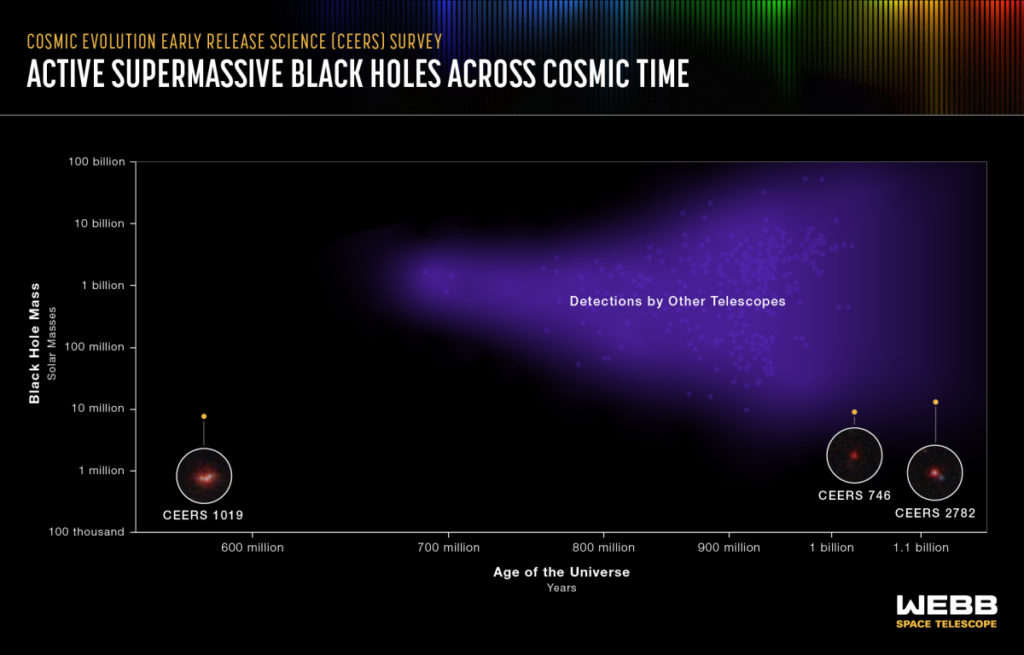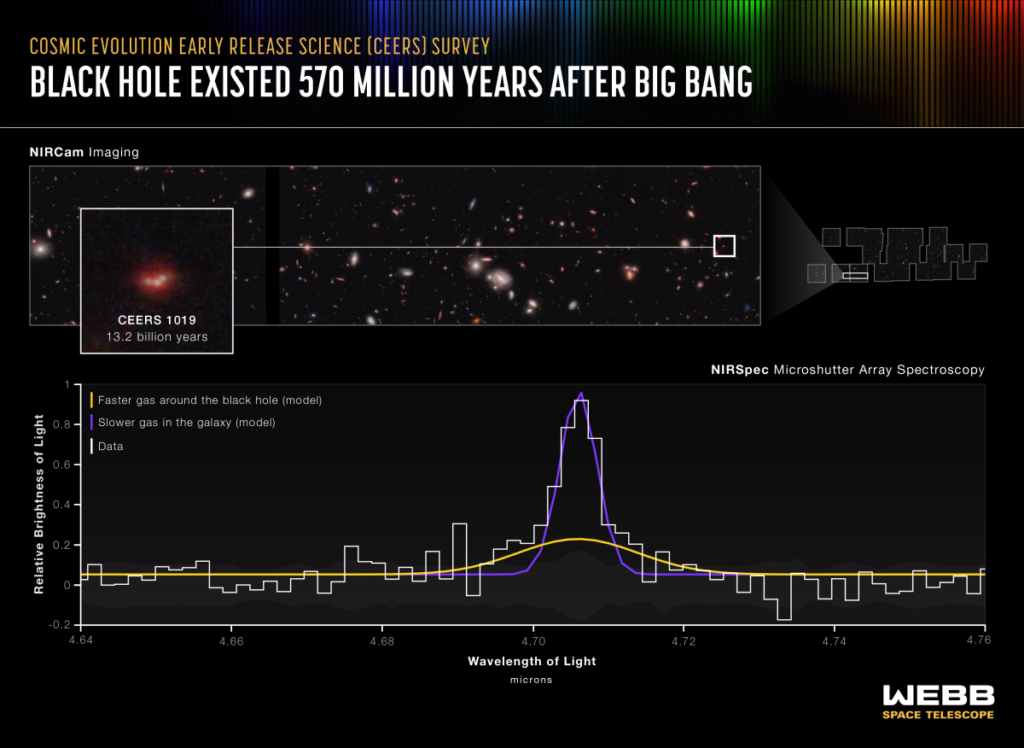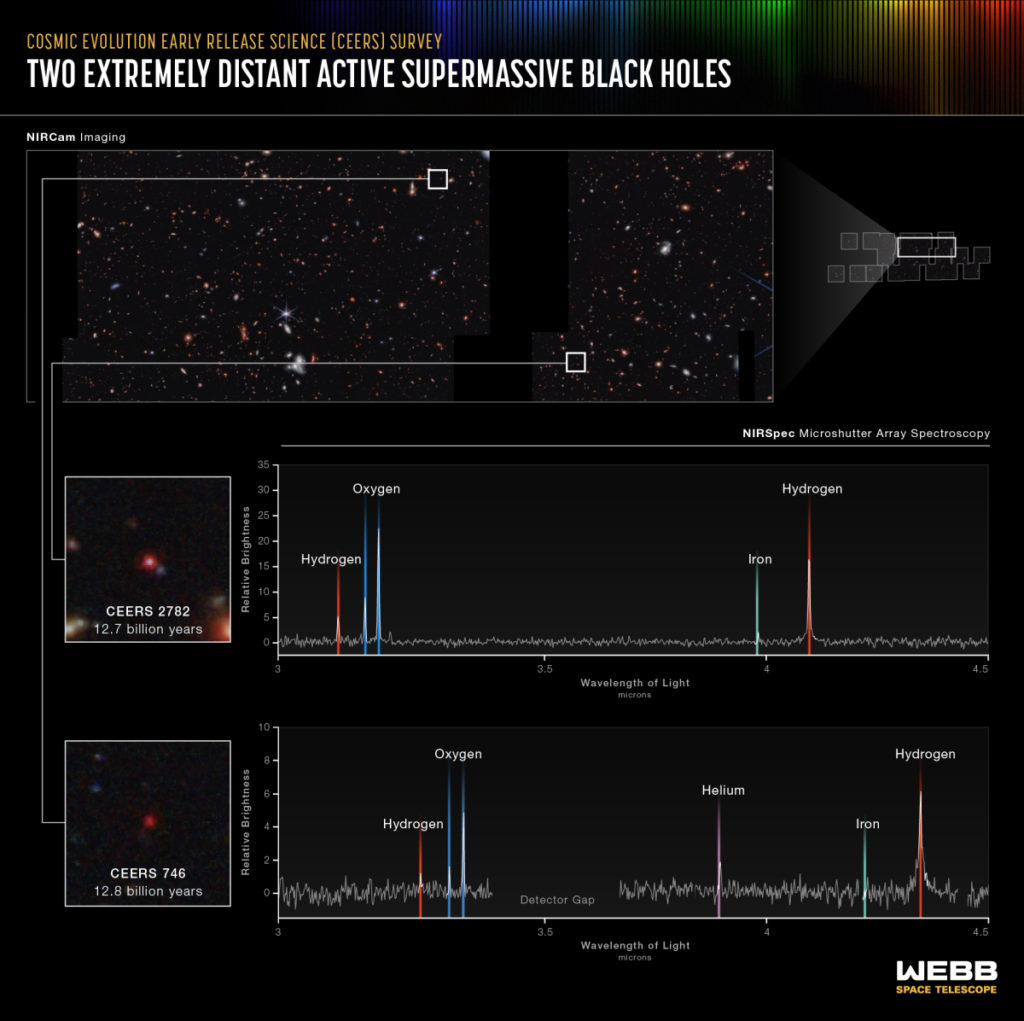James Webb Space Telescope Spots the Farthest Known Active Supermassive Black Hole
‘It is still difficult to explain how it formed so soon after the universe began.’
The James Webb Space Telescope (JWST) has made a groundbreaking observation, detecting the farthest active supermassive black hole ever observed to date.
Located within the galaxy CEERS 1019, this ancient black hole formed relatively early in the history of the universe, a mere 570 million years after the occurrence of the Big Bang. What sets this active supermassive black hole apart is not only its age and distance but also its size, weighing in at a modest 9 million solar masses, making it approximately 9 million times more massive than our sun. In contrast, most supermassive black holes in the early universe surpass 1 billion solar masses, making them more luminous and easier to detect.
The relatively small scale of the black hole at the core of CEERS 1019 presents a puzzle. The Space Telescope Science Institute in Baltimore, responsible for managing JWST’s scientific operations, expressed that “it is still challenging to explain how it formed so soon after the universe’s inception.” Astronomers have long suspected the existence of smaller black holes in the early stages of the universe, but these observations provide the first detailed evidence of such phenomena.
Dale Kocevski from Colby College in Waterville, Maine, who led one of the three new studies utilizing JWST’s capabilities to peer into the distant universe, stated, “Researchers have long known that there must be lower-mass black holes in the early universe. Webb is the first observatory that can capture them so clearly. Now we think that lower-mass black holes might be all over the place, waiting to be discovered.”
The black hole within CEERS 1019 was identified using data gathered by the James Webb Space Telescope as part of the Cosmic Evolution Early Release Science (CEERS) Survey. This research initiative aims to test and validate methods for studying the early history of the universe within a region of space positioned between the constellations of Ursa Major and Boötes. The data collected during this survey have already sparked great excitement among astronomers.
“Until now, research about objects in the early universe was largely theoretical,” explained Steven Finkelstein, an astronomer from the University of Texas at Austin and leader of the CEERS Survey, who co-authored one of the studies on CEERS 1019 utilizing JWST’s data. “With Webb, not only can we observe black holes and galaxies at extreme distances, but we can also accurately measure them. That is the immense power of this telescope.”

The James Webb Space Telescope (JWST) successfully gathered an extensive dataset of spectral information concerning CEERS 1019, which unravels the electromagnetic patterns and discloses crucial details regarding the galaxy’s chemical composition, mass, and other intrinsic characteristics. The acquired data sheds light on the active star formation occurring within the galaxy, potentially arising from a galactic merger that fuels the heightened activity observed in CEERS 1019’s central black hole.

Furthermore, alongside the discovery of the black hole residing at the center of CEERS 1019, the survey uncovered an additional pair of “lightweights” in the form of supermassive black holes with relatively smaller masses compared to the norm observed for black holes at such distances.
These two black holes are situated at the cores of galaxies known as CEERS 2782 and CEERS 746, and they formed approximately 1.1 billion years and 1 billion years after the occurrence of the Big Bang, respectively. Each of these black holes possesses a mass of approximately 10 million solar masses.
To put these findings into perspective, let’s consider the black hole residing at the core of our own Milky Way galaxy, famously referred to as Sagittarius A*. It weighs around 4.3 million times more than the mass of our sun. However, in the context of contemporary supermassive black holes, Sagittarius A* is relatively lightweight. For instance, the colossal black hole located at the heart of the galaxy M87 boasts a staggering mass of approximately 6.5 billion solar masses.

Through the utilization of JWST’s CEERS survey data, a remarkable total of 11 galaxies have been unearthed. These galaxies are believed to have emerged within the timeframe of 470 to 675 million years after the occurrence of the Big Bang. Researchers expressed that the data obtained from studying these galaxies have the potential to revolutionize astronomers’ comprehension of the formation and evolution of stars and galaxies throughout cosmic history.
Pablo Arrabal Haro from NOIRLab, who served as a lead author for one of the studies employing the CEERS survey, expressed overwhelming astonishment at the wealth of highly intricate spectra retrieved from distant galaxies by the Webb telescope. Haro stated, “These data are absolutely incredible.”
Three separate studies using CEERS Survey data have been accepted for publication in The Astrophysical Journal Letters and are available on the preprint server arXiv.
Do not forget to share your opinion with us to provide you with the best posts !




0 Comments